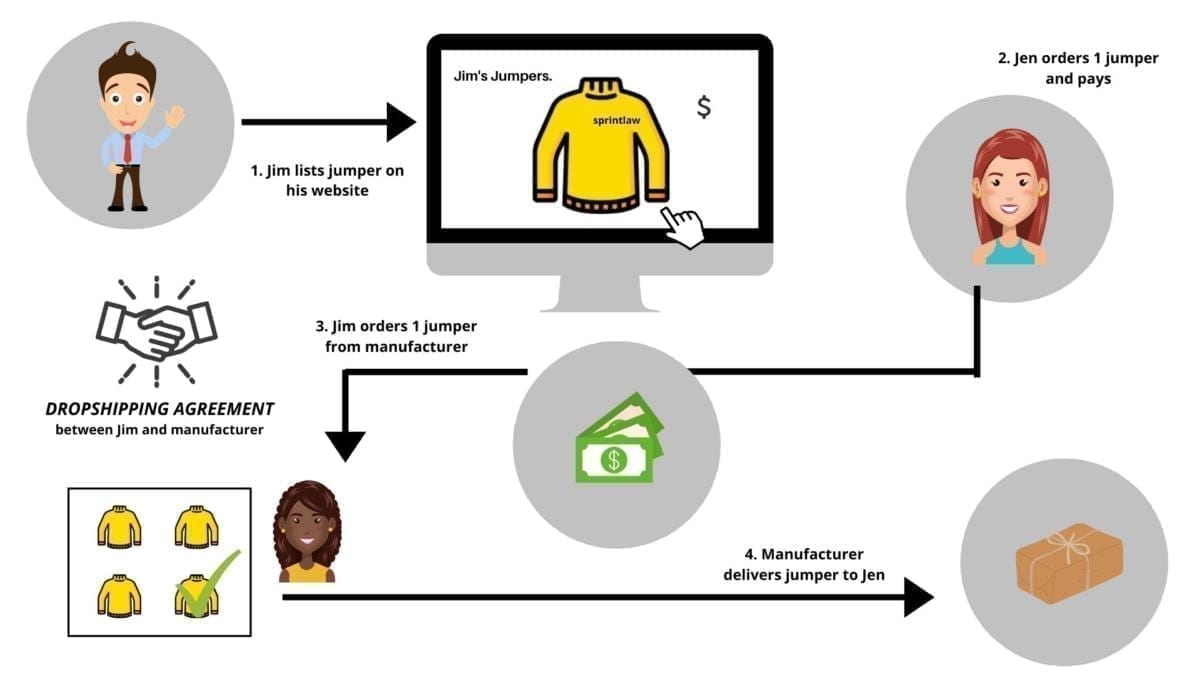Contents
If you’re thinking of running an online e-commerce business, you might be considering dropshipping to help make things easier. Dropshipping is known for being simple, cheap and efficient.
But before you get started, you need to know how dropshipping works, what contracts you need and how it can help your business.
What Is Dropshipping?
Dropshipping is a model used by online businesses to cut costs and increase efficiency.
Usually, an online retailer will purchase stock from a manufacturer or a wholesaler, and hold that stock for potential customers.
However, under a dropshipping model, the retailer doesn’t hold any stock. Instead, the retailer:
- Receives a customer’s order
- Purchases that order from a manufacturer or wholesaler
- Tells the manufacturer/wholesaler to deliver that order straight to the customer
This means the seller only purchases stock that they actually need.
Is It Like A Marketplace?
You might be thinking that dropshipping sounds a bit like a marketplace — but it’s important not to confuse the two.
Here’s the difference:
- A marketplace is an online platform that introduces two parties to each other so they can complete the selling/purchasing process on that platform (like eBay).
- Dropshipping is where the seller collects customer information, and tells the manufacturer or wholesaler to send this order to the customer directly. This requires two separate contracts.
Let’s say Jim is selling his custom made jumpers on an online marketplace called Mandy’s Market. When Mandy’s Market lists his jumpers on the website, a customer named Jen reaches out and offers to pay Jim $45 for a jumper.
Payment is organised and made through Mandy’s Market, and Jim has to arrange delivery. He is also responsible for storage of the stock.

Under a dropshipping model, things would look a bit different.
Jim, as the seller, would not be holding any jumpers just yet. However, Jen offers to pay $45 for a jumper, and Jim then places this order with his manufacturer, Jackie’s Jumpers.
When Jackie’s Jumpers has finished making the jumper, they will send the package straight to Jen.

Here, we can see that Jim did not physically hold any of the jumpers and only purchased one when Jen ordered and paid for it. Dropshipping also creates more legal relationships than in a marketplace transaction.
If you want to learn more about starting a marketplace, you can read about the required payment structures for a marketplace here.
How Will Dropshipping Help My Business?
A dropshipping model has many benefits, particularly for improving sales growth.
Customer reach
With an online platform, you’ll be able to reach more customers. And, if you have more products to offer, this variety will also attract a diverse market. More customers generally means improvements in sales growth. So, taking your business online via dropshipping could be a good move for you!
Cheap investment
Setting up a dropshipping business is actually cheaper than a usual online business.
You don’t need a large amount of money to purchase stock in the early stages because you only purchase based on what the customer has ordered.
This way, your money could be better spent on attracting new customers through digital marketing.
Low overhead expenses
Since you won’t be physically holding or managing any stock, there are lower costs and liability associated with dropshipping than with other models. For example, you won’t need to pay for a warehouse to pack and ship orders, or cover expenses such as insurance.
You won’t need to worry about these expenses because physical equipment and packing items are no longer required on your end.
Sell-through
In a traditional retail business, the seller will need to worry about selling what they’ve purchased from the manufacturer or wholesaler (sell-through).
With a dropshipping model, this will no longer be a concern because you only purchase when a customer finalises an order. This means you won’t need to stress about selling stock that hasn’t been in demand.
Accessibility
A dropshipping model is extremely accessible. All you need is a good internet connection and a device to communicate with customers and suppliers.
Investing in the right things
Through dropshipping, you can focus more on advertising a range of valuable products, rather than worrying about getting rid of the stock you’re currently holding.
Test the waters
Starting a dropshipping model is a great way to test what customers actually want before diving into the deep end of business.
You can easily identify which products your customers will buy before you commit to purchasing that stock in bulk. This is a long-term benefit for decision-making, and helps deliver results in a cost-efficient way.
If sales growth and cost-efficiency are priorities for your business, then dropshipping is definitely something worth considering.
What Are The Risks Of Dropshipping?
Dropshipping is easy to start, but it also comes with some risks.
Competition
Dropshipping has low barriers to entry, so lots of other sellers will also be setting up their dropshipping businesses.
Since it doesn’t require a lot of money to get up and running, these competitors can afford to set their prices quite low for a competitive edge.
This may make it difficult for you to stand out.
Supplier’s control
In dropshipping, you’re basically handing over your control over products to the supplier.
Things can get tricky if your supplier is also providing stock to other resellers. If they can’t guarantee your orders, then you can’t always give customers the item they were promised.
Additionally, you’d lose quality control. You can’t check the standard of the products before they are sent out to your customers, which may lead to unhappy reviews.
Returns
Faulty items may result in product returns. This means you’d need to purchase additional stock, introducing out of pocket expenses.
Additional costs
If you plan on contacting multiple suppliers, shipping can be costly. If a customer orders items from more than one supplier, you’ll need to pay for shipping costs for all those different suppliers.
Dropshipping is simple, but can get stressful when you hand over some of the responsibility. However, it can be managed well if you know how to hit the ground running.
What Legal Documents Do I Need For Dropshipping?
Dropshipping doesn’t have to be as complex as it sounds. As long as you have the right agreements in place, you’ll not only be protected from risks, but you can also get the most out of your business.
To start, you’ll need an agreement with:
- Your manufacturer (Dropshipping Agreement)
- Your customers (Terms and Conditions)
A Dropshipping Agreement will help your orders and deliveries run smoothly. It outlines everyone’s rights and responsibilities in the process. You can learn more about a Dropshipping Agreement here.
How Do I Get Started?
Dropshipping can be complex and risky if it starts on unstable ground. We’re more than happy to help you set up. Feel free to reach out to us at team@sprintlaw.com.au or contact us on 1800 730 617 for a free, no-obligations chat about setting up a dropshipping model.
Get in touch now!
We'll get back to you within 1 business day.












